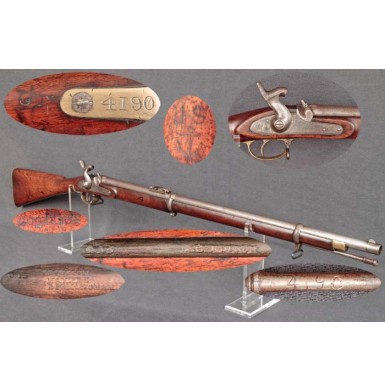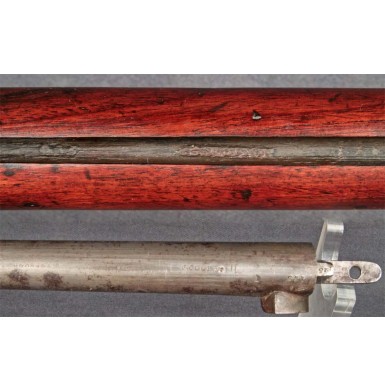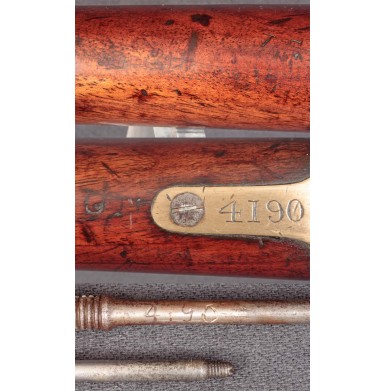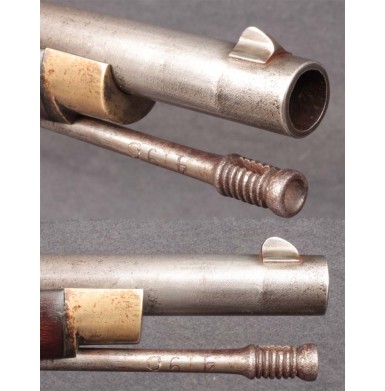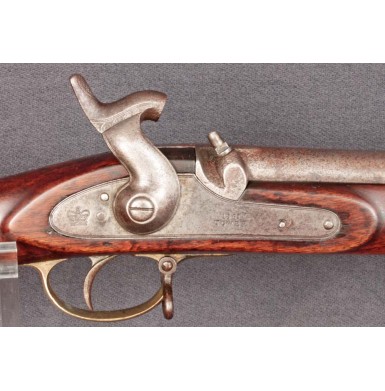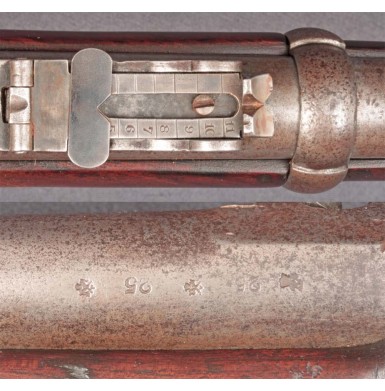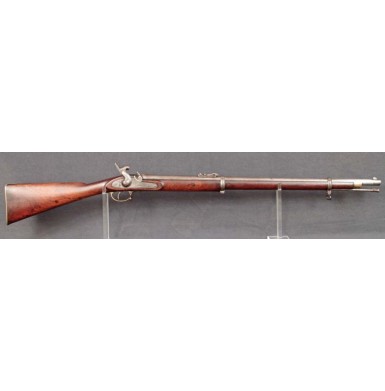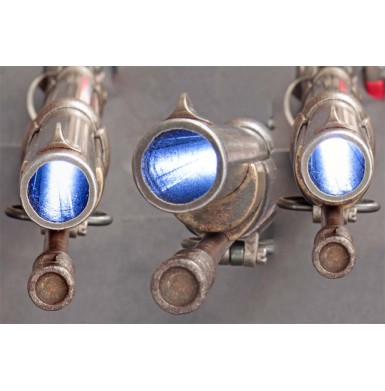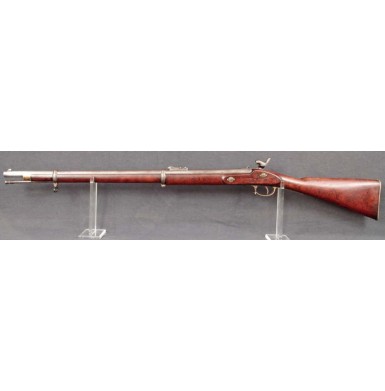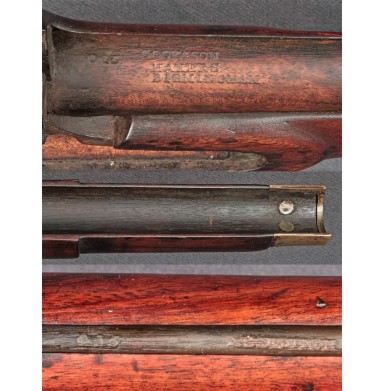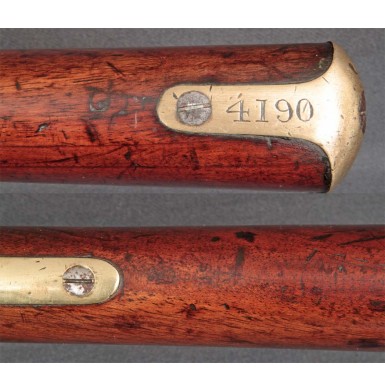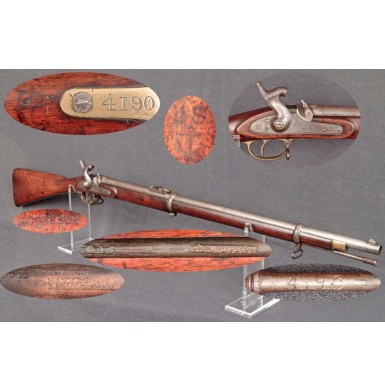Confederate JS/Anchor, Numbered Enfield Naval Rifle with CS Arsenal Alterations
- Product Code: FLA-1917-SOLD
- Availability: Out Of Stock
-
$1.00
This is a great example of a rarely encountered Confederate imported P-1858 Naval Rifle, which appears to have been repaired at one of the Richmond Armory facilities. The gun bears the highly desirable Confederate J S / (ANCHOR) viewer’s mark behind the triggerguard, and has the engraved Confederate inventory number 4190 on the tang of the brass buttplate. The ramrod is engraved with an inventory number that is 1 higher, 4191, but is has been altered to read 4090, with the 1 altered to a 0 to make the rod match. The rifle has been shortened from its original barrel length of 33” to 30” and has had a Richmond style pinched front sight added near the muzzle. The repair work is very well executed, and the 30” barrel and pinched front sight are classic characteristics of long arms “re-worked” at the Richmond Armory. Extant examples of Richmond altered or repaired .58 caliber rifles with 30” barrels exist, as do a handful of 30” barreled rifles that have been bored smooth and are now .60-.61 caliber. The fact that Richmond regularly repaired long arms is well documented, with Confederate ledgers showing 12,212 Rifles, Muskets & Carbines repaired between October 1861 and November 1863. A letter from Confederate Lt. J.W. Brown at the Richmond Arsenal, to his superior Lt. Colonel W.L. Broun noted on June 1, 1863: “The .577 Rifle Muskets examined were of the Enfield pattern, marked Tower, Windsor, Bond, Carr, Barnett & Greener that had been repaired at the Artillery Workshop in Richmond and were ready for issue.”. While this letter specifically refers to “rifle muskets’ and not “rifles”, it is a clear indication that Enfield pattern arms were being worked on in Richmond and being put back into service. The handful of extant shortened P-1853 Enfield rifle muskets with Confederate provenance, that have been altered to rifle length, is further proof that damaged arms were regularly shortened to a relatively standard length and then put back into the field. While the Richmond Armory did not always note the pattern of rifles and muskets that they repaired, in February of 1865, the arsenal did note that among the ordnance delivered to the military store keeper were 3 Enfield Rifles “ Repaired. As Enfield Rifle Muskets are also listed as being delivered to the storekeeper, it appears clear that the the reference to "rifles" indicated "short rifles".
During 1861 and 1862, the Confederacy let a number of well documented contracts for the delivery of “Enfield” pattern percussion long arms of all varieties. While the purchases concentrated on P-1853 Enfield rifle muskets for the infantry, a number of “short rifles’ and carbines were obtained as well. Confederate documents reveal that these early orders included 30,000 P-1853 “Long Enfields”, as well as approximately 10,000 “short rifles’ of varying patterns - all obtained from Sinclair, Hamilton & Company. The 40,000 guns from these contracts are the ones that appear with the J S / (ANCHOR) viewer’s mark and Confederate inventory number markings. The “Long Enfields’ were serialized in three series, from 1-9999, 1-9999 A and 1-9999 B. The short rifles were simply serialized 1-9999, without series letters. The short rifles were a mixture of standard P-1856 and P-1856 Type II (Bar on Band) iron mounted rifles, as well as non-standard brass mounted P-1856 and P-1856 Type II rifles. A handful of the brass mounted P-1858 Naval Rifles, and iron mounted P-1860 and P-1861 rifles were also purchased. The Pattern 1858 Naval Rifle was in many respects similar to the standard P-1856 rifle, but with a few minor cosmetic differences and one major performance difference. The P-1858 was a brass mounted rifle, instead of iron mounted, and had the rear sling swivel attached to the front bow of the triggerguard instead of being screwed into the toe of the stock. The P-1858 typically retained the 1,100-yard rear sight of the P-1856, but a handful of rifles with the P-1861 style 1250-yard sight have been encountered. The P-1858 retained the 33” barrel of the P-1856 rifles, but the barrel was much heavier and was rifled with 5 grooves instead of 3. The heavier barrel and improved rifling pattern made the P-1858 rifles more accurate than the P-1856. The heavier barrel also dissipated heat more effectively, resulting in less change to the point of aim / point of impact after repeated firings. The P-1858 Naval Rifle was designed to accept a cutlass bayonet instead of the standard saber bayonet, but only those Naval rifles ordered by the Confederate Navy (in their own separate inventory number range of 1-999) were delivered with the heavy cutlass bayonet. Orders by Caleb Huse for the Pattern 1858 Naval Rifle appear to be limited to about 700 guns, and these can be pinned down to two specific orders: one for 200 on June 11, 1861 and one for 500 on June 27, 1861. Huse’s order to Sinclair, Hamilton & Co specified “Sea Service Rifles, New Pattern, same bayonet as short rifles.“. This clearly indicates that Huse did not want to purchase the cutlass bayonets that the Naval Rifle was intended to accept. Based upon the documents within the McRae papers, it appears that only .07% of the numbered short rifles ordered were of the Naval Rifle pattern, which is why they are so incredibly scarce today. These rifles were all very early purchases, and those that made it through the blockade to arrive in Southern ports most certainly saw significant use throughout the war.
This Confederate purchased P-1858 Naval Rifle is a wonderful textbook example of why these guns are so scarce today. The gun has clearly seen significant service in the field, and was apparently damaged somewhere near the muzzle at some point in time. This damage necessitated repair, and the result was that the barrel was cut back by 3” to 30” in length. With the removal of the muzzle portion of the barrel, a new front sight had to be installed, and a classic Richmond Armory “pinched” front sight was added near the muzzle. Even though the gun saw significant service and arsenal repair, it remains in about VERY GOOD condition. As previously noted, the gun bears the expected the J S / (ANCHOR) viewer’s mark and has the Confederate inventory number 4190 engraved in the buttplate tang. The ramrod is also engraved with the inventory number 4091, which has been altered to read 4190. It is not clear if the alteration of the 1 to a 0 took place in modern times, or during the period of use and possibly during the repair. The rod has been appropriately shortened and re-threaded for use with a 30” barreled rifle, so it is clear that the numbered rod was with the gun when it was repaired in Richmond. Today there are very few numbered Confederate guns that retain an original engraved number ramrod, and even fewer that retain a rod numbered to the gun. Numbered rammers, when found for sale, often bring $1,000 on the open market, and increase the value of a gun by at least that much when they are encountered together. The top of the stock comb, in front of the buttplate tang, is also marked with a large S, indicating that Scott & Son of Birmingham was the “furnisher” of the rifle to Sinclair, Hamilton & Company. Sinclair, Hamilton & Co utilized five primary furnishers to provide the guns for Confederate orders. These companies included EP Bond, Parker Field & Sons and James Kerr of London, and CW James and Scott & Sons of Birmingham. While these “furnishers’ received the contract to deliver the arms, they often outsourced the production of the guns to other makers in their area, who would deliver the finished guns to the furnisher. Each of the furnishers would often mark the guns with a single initial (B, F, K, J & S respectively) on the comb of the stock, indicating that no matter what maker name might be on the gun, that furnisher was the one delivering the gun to Sinclair, Hamilton & Company. Scott & Sons delivered thousands of Enfield pattern arms to the Confederacy through Sinclair, Hamilton & Company, and delivered 8,000 of the 30,000 JS/Anchor marked, inventory numbered P-1853 rifle muskets that were procured. This made Scott the second largest provider of P-1853s under that contract, with only CW James delivering more P-1853 long arms. The toe of the stock is marked by the contractor that manufactured the gun, in this case COOK & SON. John Thomas Cook was listed in the Birmingham directories as a Gun & Pistol Maker and Gunsmith, operating from 1855 through 1875. From 1855 -1861 his company was at 88 Shadwell Street and 80 New Street, and in 1862 he moved the New Street location to Bridge Street West, but left the Shadwell Street address in operation. It is not clear if these two simultaneous addresses represented a manufacturing location and a retail location, or if one of the locations was just simply additional workspace. Shadwell Street was the northwest boarder of the gun trade district in Birmingham, and was also the address for famed Birmingham maker Eyton Bond (brother of London’s EP Bond). The bottom of the barrel is also marked J COOK as is the interior of the lock, over the mainspring. The interior of the barrel channel is clearly stamped in three lines: COOK & SON / MAKER’s / BIRMINGHAM, and the ramrod channel is also marked COOK & SON. The underside of the barrel is also marked BEASLEY’s, indicating that Birmingham’s William Beasley (originally of Beasley & Farmer) was the gun barrel maker who made the barrel. The barrel and breech plug have the matching mating numbers of 125 and the barrel is additionally marked 128. In typical Birmingham fashion, the bottom of the barrel, the ramrod channel and the upper edge of the lock plate are all marked with the mating code: | | |. These same file slash mating marks are also found on the necks of the tang screw and both lock mounting screws. An additional, non-traditional mating code is also found in the stock. Both the interior of the barrel channel and the ramrod channel are stamped C 15. This alphanumeric code is reminiscent of the types of reassembly marks used by several of the US arsenals during the alteration of flintlock muskets to percussion, and may be a mating or assembly code used when the barrel of the rifle was shortened and repaired. The interior of the lock, the bottom of the barrel and rear of the breech plug are all marked JW, which may be the initials of the “setter up” who performed the final assembly of the gun for Cook. The rifle is clearly marked on the lock plate with the typical English (CROWN) to the rear of the hammer and 1861 / TOWER forward of the hammer. The lock functions perfectly on all positions and is mechanically excellent. The lock retains light traces of its original case hardened finish, with some traces of blue and purple color under a mottled gray-brown patina. The lock and hammer show light scattered pinpricking, indicative of the gun being fired many times. The barrel of the rifle is clearly marked with typical Birmingham commercial proof and view marks, as well as a pair of 25 gauge marks, indicating .577 caliber. The barrel is mostly smooth forward of the rear sight, with some scattered pinpricking and light peppering from the sight forward along its entire length. There is some light pitting present around the breech and bolster area, extending to the base of the rear sight. The exterior surface of the barrel has been lightly cleaned and has faded to a medium pewter patina, with scattered minor patches of oxidized age discoloration. The bore of the rifle retains the original and correct pattern 5-groove rifling, and rates about GOOD+. The rifling remains clear and distinct, but the bore is somewhat dirty and shows light to moderate pitting along its entire length, with a couple of patches of more serious pitting near the muzzle. The gun retains its original 1,250-yard rear sight. This pattern of sight was adopted by the British in 1860 and was formalized with the adoption of the Pattern 1861 Short Rifle. The new sight was necessary due to the new J2 gunpowder formulation in use with the British military. These sights are only rarely encountered on exported rifles with Confederate provenance. As the new pattern sight was correct for use as of 1861, they were available for the gun makers to utilize. The sight is lightly marked W&S on the left side, indicating that it was supplied by W Scott & Son, the furnisher who delivered the gun to Sinclair, Hamilton & Company. The front sight, as previously noted, is the “pinched” Richmond pattern replacement. The original bayonet lug was lost when the rifle barrel was shortened, and the gun is no longer capable of accepting a bayonet. The original sling swivel is in place on the triggerguard of the rifle, but the upper swivel on the upper barrel band is a modern replacement of reasonably good quality. The gun is missing both of the screw protecting doughnuts on the end of the barrel band tension screws, which is typical of a gun that was disassembled and refurbished during the period of use. The brass furniture appears to have been lightly cleaned in the past, but is toning down and has developed a medium golden patina that is quite attractive. The stock of the rifle rates about VERY GOOD+. The stock is full-length with no breaks or repairs. The stock does show a significant number of bumps, dings and impact marks from actual use and service in the field. Considering that the gun arrived in the Confederacy no later than early 1862, and clearly fought long enough to be arsenal refurbished, the stock is in amazingly good condition.
Overall this is a really fascinating example of the very scarce Confederate marked P-1858 Naval Rifle. These guns are actually more scarce than the Confederate Naval contact version, as that contract was for 1,000 guns and the invoices in the McRae papers indicate that only 700 of the 10,000 JS/Anchor marked short rifles purchased by Huse were of the P-1858 Naval pattern. CS numbered Enfields are rarely found for sale with an original numbered ramrod, and even though this rod is really one number off, the modifications to it indicate that it spent most of its service life in the channel under the barrel of this gun. For the student of Confederate long arms, this gun is simply an iconic example. It is a very rare pattern Enfield short rifle, it has a clear JS/Anchor mark as well as a fantastic engraved Confederate inventory number and it has all of the hallmarks of having been refurbished in the Richmond Arsenal complex. This gun could easily represent both a Confederate import and a Richmond Armory gun in a collection. While all Confederate weapons have a great story and interesting history behind them, this one is simply about as cool as it gets. This is absolutely one of those fantastic pieces of Civil War history that we wish could tell us its story.
SOLDTags: Confederate, JS, Anchor, Numbered, Enfield, Naval, Rifle, with, CS, Arsenal, Alterations

